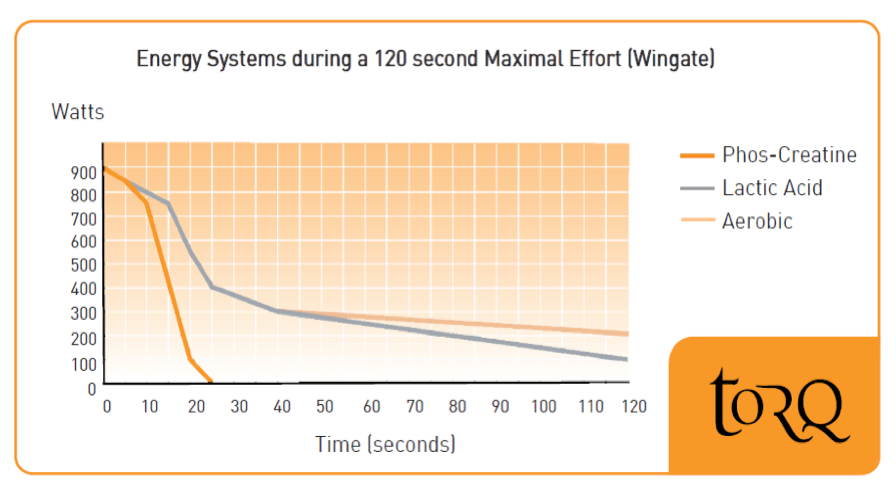Learn
- Cols //
- Cycling Tours //
- Learn //
- Ask the experts //
- Shop
Power to the Pedals - We take a Closer Look at Energy Systems with Torq Fitness
TORQ Season 1: An introduction to the body's three main energy systems

As you exercise, your working muscles require a constant supply of energy. In order to satisfy this need the body relies upon three energy systems, working seamlessly together to turn the fuel that we eat into the watts that we produce to turn the pedals. Fundamental to all nutrition and training theory is a clear understanding of these systems, so for our first TORQ/Col Collective, ‘Learn Article’ in the series, we are going to give you an overview of what these systems are and how they work.
The energy systems can be divided into two main categories, aerobic (requiring oxygen) and anaerobic (not requiring oxygen). The anaerobic system can then be further divided into, the ATP-Phosphocreatine system which is alactic (doesn’t produce Lactic Acid) and the Glycolytic or Lactic Acid system (which does produce Lactic Acid).
Anaerobic – Phosphocreatine (PCr) System
Have you ever wondered why when you first start sprinting the first 10-15 seconds feel almost effortless? During these short, high power bursts the body has to rely on a fuel that can provide energy instantaneously, here’s where the Phosphocreatine system comes in.
This system breaks down phosphate and creatine stored in the muscles and has the capacity to produce vast quantities of energy very quickly. It is the only system that doesn’t require a blood supply and has no by products. Like all good things though, the effortless burst of power that the system produces doesn’t last and as soon as the muscle limited stores of PCr are depleted in around 10-15 seconds, the Lactic Acid system kicks in, and you quickly become aware of your efforts! Once you have depleted you PCr stores in a sprint it can take as long as 5 minutes to restore them to their resting levels, ready to sprint again. The PCr system is the lesser known of the three energy systems, but is still equally as important as the other two since it is called upon at the start of activity and during any fast bursts of speed.
Anaerobic – Lactic Acid System (LA)
This system breaks down carbohydrate, a fuel in limited supply in the body, to produce medium amounts of power for medium amounts of time. Its by-product, lactic acid, can accumulate in the muscles during very high intensity exercise, creating an acidic environment which wreaks havoc with the body’s enzymes, causing a great amount of physical pain and resulting in an eventual drop in performance as the muscles function is inhibited.

The anaerobic systems use of carbohydrate is significant, as the body’s stores in the muscle and liver only equate to around 500grams (2000Kcal) worth of carbohydrate, which can be completely exhausted in as little as 60minutes when exercising at a high intensity. Any breathless cycling would be heavily reliant on this system, which would result in rapid use of carbohydrate, a good example of which would be attacking a mountain col. Relying on this system will allow you to go quickly, for as long as the fuel in your body lasts which is the basis for fuelling during exercise.
The Aerobic System
This is commonly referred to as your body’s diesel engine. It is a system that produces energy through the combustion of carbohydrate and fat in the presence of oxygen. It is only able to produce relatively small amount of energy, so cannot produce enough energy for any sprinting, but can produce power for extended periods of time, making it the predominant system used during any endurance ride.
Due to the requirement of oxygen for the system to work, there is a time lag between starting exercise and the oxygen being delivered to the working muscle to allow the system to function, which can be as much as 120 seconds in some individuals.
Although some carbohydrate is required to burn fat, the major fuel is fat which is stored in abundance in the body. An average person can have between 50,000 – 60,000 calories stored in the body which is enough to cycle over a thousand miles without having to refuel making it, arguably, the most important of the three energy systems for any endurance athlete!

How much power this system produces is dependent upon your own fitness, typically if a lot of your training is of a long duration, you will have developed a good Aerobic system. The Col Collective’s Mike Cotty, for example, could produce 200 Watts at his aerobic threshold back when we tested him in June 2013, which equates to 3.2watts per kilogram of his body weight. Aerobically, Mike can produce more power at his aerobic threshold than your average club cyclist at their anaerobic threshold, which may at least partly explain why he is able to ride at a consistent pace over a significant distance as demonstrated in some of his epic challenges!
Click on the image below to watch the video from Mike’s fitness test to see how we came to these figures.

To illustrate how these systems work together, we can look at the contribution of these three systems to the power produced during a 120 second sprint, or a Wingate Test as it’s known in sports science laboratories. Individuals are placed on a static bike and asked to sprint as fast as they can for 120 seconds. When the contribution of each of the energy systems is graphed it looks something like this….

As you can see, the first 10-15seconds is fueled almost entirely by the PCr system, producing a huge burst of power (peaking at 900watts!), but very quickly fatiguing. After around 10 seconds the Phos-creatin system is completely exhausted and the lactate acid system starts to kick in. By 30 seconds the LA system has fully taken over, but rapidly starts to fatigue as lactate acid accumulates. By 40 seconds, the aerobic system has begun to kick in as oxygen has made it to the working muscle and begins to assist with the aerobic contribution of energy production.
As an athlete, it is important to have all three systems working at their optimum so that any system can be called upon to produce energy for the working muscle. In the next few articles we shall cover how to determine the strengths of each of these systems through testing.
By Ben Price at Torq Fitness
For more help and advice why not ASK THE EXPERTS
Topic: Fitness
More advice in this topic

How to make the most of your indoor training time?

Recovery Tips for Riding a Multi-Day Event

Five tips to help you climb better

Mike Cotty’s 15 Minute Stretching Routine

How to train for the mountains if you live on the flat?

Making the most of your winter training with Torq Fitness












